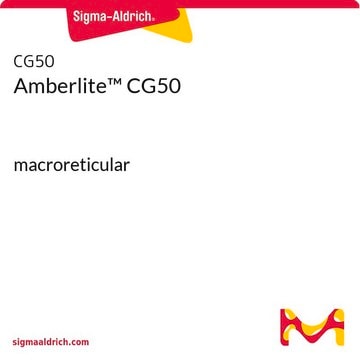G1910
Gelzan™ CM
Gelrite®
Synonym(s):
Gellan Gum, Agar substitute gelling agent
Sign Into View Organizational & Contract Pricing
All Photos(2)
About This Item
Recommended Products
application(s)
agriculture
Looking for similar products? Visit Product Comparison Guide
Related Categories
General description
Gelrite, gellan gum, is recommended as a gelling agent for use in place of agar in microbiological assay and tissue culture media. Gellan gum is used in a wide variety of immobilization matrices. It forms a hard gel at low concentrations in the presence of an electrolyte. Gellan is a linear tetrasaccharide composed of D-glucose, L-rhamnose, and D-glucuronic acid in the ratio of 2:1:1, linked by β (1 → 4) glycosidic bond.
Gelrite, gellan gum, is recommended as a gelling agent for use in place of agar in microbiological assay and tissue culture media. Gellan gum is used in a wide variety of immobilization matrices. It forms a hard gel at low concentrations in the presence of an electrolyte. Gellan is a linear tetrasaccharide composed of D-glucose, L-rhamnose, and D-glucuronic acid in the ratio of 2:1:1, linked by β (1 → 4) glycosidic bond.
Application
Gelrite, gellan gum, is recommended as a gelling agent for use in place of agar in microbiological media. Gellan gum is used in a wide variety of immobilization matricies.
Gelzan™ CM has been used:
- in the synthesis of gellan-pullulan nanogel via chemical crosslinking
- in the synthesis of gellan-pullulan hydrogel
- with KNOP medium to maintain and prepare Anthoceros agrestis thallus tissue sample for imaging
Gelzan™ CM has been used:
- in the synthesis of gellan-pullulan nanogel via chemical crosslinking
- in the synthesis of gellan-pullulan hydrogel
- with KNOP medium to maintain and prepare Anthoceros agrestis thallus tissue sample for imaging
Features and Benefits
- Transparent and colorless agar alternative
- Mechanically robust
- Disperses in water with ease
- Low viscosity
- The resulting gel has a high melting temperature
Legal Information
Gelrite is a registered trademark of CP Kelco U.S., Inc.
Gelzan is a trademark of CP Kelco U.S., Inc.
Storage Class Code
11 - Combustible Solids
WGK
WGK 2
Flash Point(F)
Not applicable
Flash Point(C)
Not applicable
Personal Protective Equipment
dust mask type N95 (US), Eyeshields, Gloves
Certificates of Analysis (COA)
Search for Certificates of Analysis (COA) by entering the products Lot/Batch Number. Lot and Batch Numbers can be found on a product’s label following the words ‘Lot’ or ‘Batch’.
Already Own This Product?
Find documentation for the products that you have recently purchased in the Document Library.
Customers Also Viewed
Timothy E L Douglas et al.
Biomedical materials (Bristol, England), 12(2), 025015-025015 (2017-02-23)
Injectable composites for tissue regeneration can be developed by dispersion of inorganic microparticles and cells in a hydrogel phase. In this study, multifunctional carbonate microparticles containing different amounts of calcium, magnesium and zinc were mixed with solutions of gellan gum
Timothy E L Douglas et al.
Journal of biomedical materials research. Part A, 106(3), 822-828 (2017-10-24)
Mineralized hydrogels are increasingly gaining attention as biomaterials for bone regeneration. The most common mineralization strategy has been addition of preformed inorganic particles during hydrogel formation. This maintains injectability. One common form of bone cement is formed by mixing particles
Marco A Lopez-Heredia et al.
Journal of tissue engineering and regenerative medicine, 12(8), 1825-1834 (2018-04-28)
Mineralization of hydrogels is desirable prior to applications in bone regeneration. CaCO3 is a widely used bone regeneration material, and Mg, when used as a component of calcium phosphate biomaterials, has promoted bone-forming cell adhesion and proliferation and bone regeneration.
J T Oliveira et al.
Journal of tissue engineering and regenerative medicine, 3(7), 493-500 (2009-07-15)
Gellan gum is a polysaccharide that has been recently proposed by our group for cartilage tissue-engineering applications. It is commonly used in the food and pharmaceutical industry and has the ability to form stable gels without the use of harsh
Zhuoran Jiang et al.
ACS applied materials & interfaces, 11(31), 28289-28295 (2019-07-11)
Poly(tetrafluoroethylene) (PTFE) is a unique polymer with highly desirable properties such as resistance to chemical degradation, biocompatibility, hydrophobicity, antistiction, and low friction coefficient. However, due to its high melt viscosity, it is not possible to three-dimensional (3D)-print PTFE structures using
Protocols
Reference guide and preparation guide for antibiotic and antimycotic use in plant tissue culture.
Our team of scientists has experience in all areas of research including Life Science, Material Science, Chemical Synthesis, Chromatography, Analytical and many others.
Contact Technical Service















